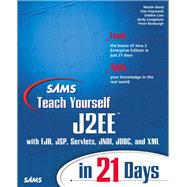J2EE has become required knowledge for any serious Java developer, but learning this large and complex specification requires a substantial investment of time and energy. Sams Teach Yourself J2EE in 21 Days presents the enterprise Java architecture in accessible, easy-to-comprehend lessons, describing how each J2EE tool solves the challenges of n-Tier development. Using the architecture as a roadmap, following chapters describe Enterprise JavaBeans (EJB), JavaServer Pages (JSP), servlets, and more, giving readers a full understanding of J2EE development.
Further chapters cover the role of XML, custom JSP tags, and how Java Connectors allow J2EE applications to interact with legacy and non-Java systems. The book finishes with sample applications that put all the pieces together, including an example using J2EE to create Web Services. Along the way, every concept is illustrated with practical, real-world examples to ensure understanding by Java students as well as experts.







